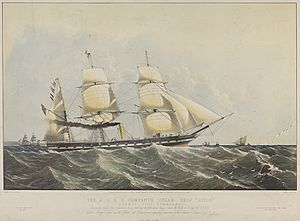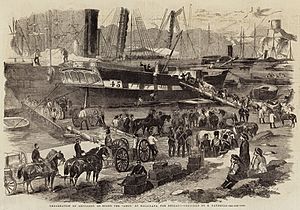Argo (1853 ship) facts for kids

The G.S.S.S. Company's Steam Ship Argo, entering The Needles from Australia having performed the first steam voyage around the World in 121 days, 26 October 1853
|
|
Quick facts for kids History |
|
|---|---|
| Builder | C.J. Mare and Company, Leamouth, London |
| Fate | Wrecked 28 June 1859, Trepassey Bay, Newfoundland |
| General characteristics | |
| Displacement | 1,815 long tons (1,844 t) |
| Length | 254 ft (77 m) |
| Beam | 39 ft (12 m) |
| Propulsion |
|
| Speed | Average speed 10 knots (19 km/h) (steam or sail) |
| Capacity | 210 passengers |
| Complement | 120 |
Argo was a special ship built in 1853. She was made of iron and used a new type of engine with a "screw" (like a propeller) to move through the water. Argo became famous for being the first ship of her kind to travel all the way around the world!
Before Argo, another ship called HMS Driver had already sailed around the world using steam power, but she used big side paddles instead of a screw. Argo was also used as a Troopship to carry soldiers during the end of the Crimean War.
Contents
History of the Argo
Building a New Kind of Ship
The ship Argo was built by a company called C.J. Mare and Company in London. She was launched in 1853. Argo had three masts for sails and one tall funnel for her steam engine. She also had a special front part called a "clipper bow," which helped her cut through the waves.
Argo was an early example of a "screw-propelled" ship. This meant she used a propeller, like a big fan, under the water to push herself forward. But she also had full sails, so she could use wind power too. When she used her sails, her propeller could be "feathered." This meant it could be turned so it didn't slow the ship down. This change took only about 7 minutes! The propeller could even be lifted out of the water for checks while the ship was sailing. During her tests, Argo proved to be a very good sailing ship, reaching speeds of about 10 knots (18.5 km/h).
Sailing Around the World
On May 8, 1853, Argo began her amazing journey. Under the command of Captain George Hyde, she sailed from Southampton, England. She reached Melbourne, Australia, in just 64 days, stopping once along the way at Cape St. Vincent.
For her return trip, Argo sailed around Cape Horn, which is at the very tip of South America. This part of the journey took 63 days. When she arrived back in England, everyone was very excited. She was celebrated as the first steamship with a screw propeller to sail all the way around the globe!

Helping in the Crimean War
After her world trip, the British Government hired Argo to be a troopship. She helped bring soldiers and horses back from the Crimean War in 1855. She made several trips between the Crimea and Southampton.
On May 30, 1856, something unexpected happened. A French warship called the Tourville accidentally crashed into Argo near Marmara Island. Argo had to go to Constantinople for repairs. When she finally returned to Spithead in England on August 4, 1856, Queen Victoria herself was there to welcome her!
The Final Journey
In 1857, Argo was sold along with all the other ships from the General Screw Company. In 1859, she was rented by another company called the Galway Line.
Sadly, on June 28, 1859, during her very first trip back home for the Galway Line, Argo ran into trouble. She hit a hidden reef in thick fog in Trepassey Bay, Newfoundland. The ship was wrecked, but thankfully, everyone on board was safe, and no lives were lost.


